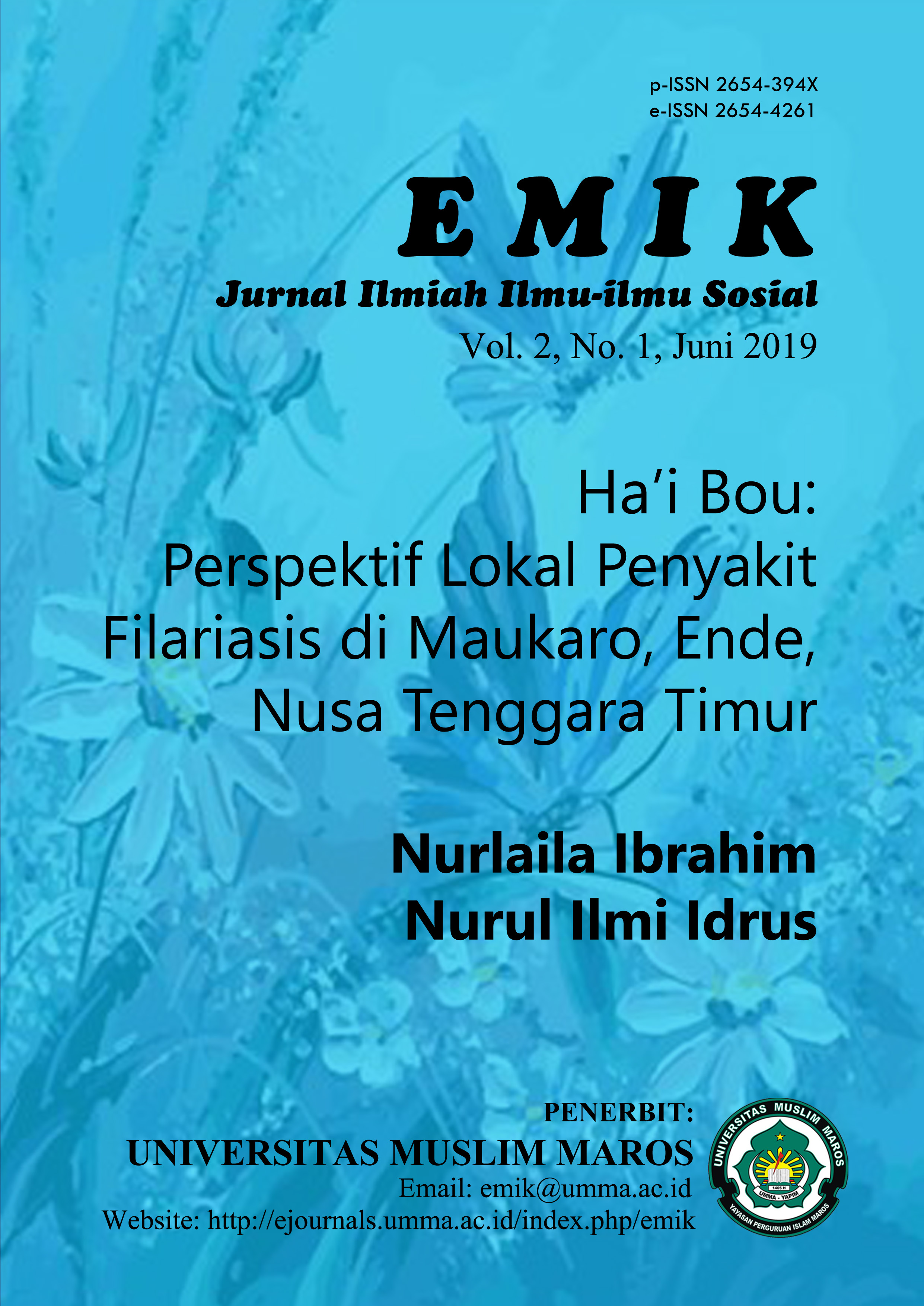Ha'i Bou
Perspektif Lokal Penyakit Filariasis di Maukaro, Ende, Nusa Tenggara Timur
Keywords:
Filariasis, Ha’i Bou, Response, Care, Wuza KessuAbstract
Filariasis, which is locally termed as ha’i bou, is one of the potential infectious disease found in the tropical areas. The existing literatures disputes the problem of elephantiasis from a medical perspective, while rarely (if any) the debate about how filariasis is perceived locally (emic perspective) and this is related to how they seek, care for, prevent and treat it. This article fills this gap.
This ethnographic study was conducted in Maukaro Subdistrict, Ende, NTT since the area is filariasis endemic with 60% of cases of filariasis sufferers found in some villages. There sixteen informants who participated in this study, consisting of eleven filariasis sufferers, the rest were Puskesmas and Dinas Kesehatan staf, a community leader, and a family member of filariasis sufferer. Data was collected using in-depth interview to explore the local knowledge of the community about filariasis, its etiology, the symptoms and characteristics of filariasis, and how they respond; while observations were made to see how the daily lives of the Maukaro people, especially those who suffer from filariasis, their interactions and the conditions of their surrounding environment.
The study indicates that filariasis is socially understood as a curse from God and ancestors (embu mamo nitu pa'i) for intentionally killing animals during the process of searching for food in the forest or in the fields. Filariasis is locally divided into two characteristics, namely ha'i bou fai (female elephantiasis disease) and ha'i bou aki (male elephantiasis disease). Despite the fact that the characteristics of the disease differ by gender, this difference is more associated with whether or not the disease is chronic rather than differences based on gender, and how they deal with it is also genderless. Ha’i bou can be experienced by anyone regardless of gender. While ha’i bou aki is relatively curable as long as it is adequately treated with good self care, ha'i bou fai has so far non curable yet. However, ha'i bou aki can be increased to ha’i bou fai depending on how the patient maintains and takes care of his/her personal hygiene. The Maukaro people believe that the cause of the disease consists of two, namely rangka atas (relating to God / Du'a ngga'e and air / angi) and rangka bawah (related to land, water and environmental conditions). In relation to ha’i bou, the latter is more dominant than the former, and it is believed that the land, water, and environment each have positive and negative characteristics. Not maintaining the environment is likened to "inviting disease".
References
Arsin, A. 2016. Epidemiologi Filariasis di Indonesia. Makassar: Mesagena Press.
Bryant, E.J.; King, N.A., and Blundell, J.E. 2008. “Disinhibition: Its Effect on Appetite and Weught Regulation”, Obes Rev., 9(5):409-419, diakses tanggal 1 Mei 2019.
Foster, G. M. dan Anderson, B. G. 2006. Antropologi Kesehatan. Jakarta: UI-Press.
Gedrich, Kurt. 2014. “Determinants of nutritional behaviour: A multitude of Levers for Successful Intervention?”, Appetite, January, 41(3):231-238, diakses tanggal 15 Maret 2019.
Hays, N.P. and Rooberts, S.B. 2008. “Aspects of Eating Behaviors ‘Disinhibition’ and ‘Restraint’ are Related to Weight Gain and BMI in Women”, Obesity, January, 16(1):52-58, diakses tanggal 15 April 2019.
Ipa, M.; Astuti, E.P.; Hendri, J.; Yuliasih, Y.; dan Ginanjar, A. 2016. Menghapus Jejak Kaki Gajah. Yogyakarta: Penerbit PT. Kanisius.
Indriyati L.; Waris, L.; Rahman, A; dan Juhariyah. 2013. “Epidemiologi Filariasis di Kabupaten Nunukan”. Jurnal Epidemiologi dan Penyakit Bersumber Binatang. 4(4):155-161, diakses tanggal 27 Mei 2018.
Komariah, R.H.; Faisya, H.A.F.; Sunarsih, E. 2016. “Analisis Determinan Lingkungan Fisik dan Prilaku Preventif Terhadap Kasus Filariasis di Kecamatan Talang Kelapa dan Kecamatan Sembawa, Kabupaten Banyuasin”, Jurnal Ilmu Kesehatan Masyarakat, Juli, 7(2):108-117, diakses tanggal 21 April 2019.
Malinowski, B. 1955. Magic, Science, and Religion. New York: Doubleday & Company, Inc.
Masrizal. 2012. “Penyakit Filariasis”. Jurnal Kesehatan Masyarakat, 7(1):32-38.
Profil Kesehatan NTT. 2015. Revolusi KIA NTT: Semua Ibu Hamil Melahirkan di Fasilitas Kesehatan yang Memadai. Nusa Tenggara Timur: Dinas Kesehatan Provinsi Nusa Tenggara Timur.
Rizki, A. K. 2012. Studi Pola Persebaran Penyakit Filariasis di Kabupaten Bandung. Bandung: Universitas Pendidikan Indonesia.
Sitorus, H.; Santoso; Budyanto, A., Ambarita, L.P., Hapsari, N. dan Yulian, T. 2015. “Keanekaragaman Spesies Nyamuk di Wilayah Endemis Malaria di Oku Selatan. Loka Litbang Pengendalian Penyakit Bersumber Binatang Baturaja”. Balaba, 11(2):97-104.
Siahaan, J. 2009. Prilaku Menyimpang: Pendekatan Sosiologi. Jakarta: Indeks.
Widoyono 2011. Penyakit Tropis: Epidemiologi, Penularan, Pencegahan dan Pemberantasannya. Jakarta: Erlangga.










9.png)















